 Best Python IDEs and Code Editors You Should Know
Best Python IDEs and Code Editors You Should Know
Developing machine learning algorithms requires implementing countless libraries and integrating many supporting tools and software packages. All this magic must be written by you in yet another tool -- the IDE -- that is fundamental to all your code work and can drive your productivity. These top Python IDEs and code editors are among the best tools available for you to consider, and are reviewed with their noteworthy features.
By Claire D. Costa, Content Writer and Strategist at Digitalogy LLC.

Photo by luis gomes from Pexels.
Python is an experiment in how much freedom programmers need. Too much freedom and nobody can read another’s code; too little and expressiveness is endangered. - Guido van Rossum
Since its creation, Python has rapidly evolved into a multi-faceted programming language, becoming the choice of several diverse projects ranging from web applications to being deployed into Artificial Intelligence, Machine Learning, Deep Learning, and more.
Python comes with numerous features such as its simplicity, enormous collection of packages and libraries, with relatively faster execution of programs, to list a few.
GitHub’s second-most popular language and the most popular language for machine learning.
For a programmer, a Code Editor or an IDE is the first point of contact with any programming language, making its selection one of the most crucial steps in the journey ahead. Throughout this article, we’ll discuss some of the top Python IDEs and Code Editors, along with the reasons why you should and shouldn’t pick them for your next project.
According to StackOverflow, Python is the fastest-growing major programming language: Stack Overflow Developer Survey 2019
What is an Integrated Development Environment (IDE)?
An IDE stands for Integrated Development Environment and includes not just the standard code editor for managing the code but also provides a comprehensive set of tools for its debugging, execution, and testing, which is an absolute must for software development. Some IDEs also come with built-in compilers and interpreters. Listed below are some of the standard features common IDEs offer within a single dedicated environment:
- Syntax highlighting
- Build automation
- Version control
- Visual programming
- Code formatting and completion
- Code refactoring
- Support for integration with external tools
IDE vs. Code Editor
A Code Editor or an IDE is the most fundamental piece of software for any programmer, and it is what they start and end their day. To achieve its maximum potential, the best starting point is a Code Editor or an IDE that essentially lets you work with Python, but that’s not all. A host of programming languages can work entirely without an IDE, while some are IDE-dependent.
Code Editor — A Code Editor is a core piece of software that programmers use for application development. Think of it as a simple text editor but with additional programming-specific advanced features such as:
- Syntax highlighting
- Code formatting
- Split file viewing and editing
- Instant project switching
- Multiple selections
- Cross-platform support
- Light-weight
IDE — On the other hand, an IDE comes with a suite of tools that help in not just developing the application but also in its testing, debugging, refactoring, and automating builds. Needless to say, in most cases, an IDE can offer all features of a Code Editor, but a Code Editor cannot replace an IDE.
Best Python IDEs and Code Editors in 2020
Choosing the right tools for a job is critical. Similarly, when starting a new project, as a programmer, you have a lot of options when it comes to selecting the perfect Code Editor or IDE. There are loads of IDEs and Code Editors out there for Python, and in this section, we’ll discuss some of the best ones available with their benefits and weaknesses.
- PyCharm
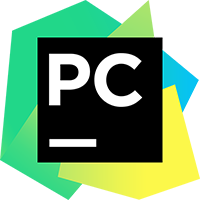
Image Source — PyCharm.
- Category: IDE
- First Release Date: 2010
- Platform Compatibility: Windows, macOS, Linux
- Who It’s For: Intermediate to advanced Python users
- Supporting Languages: Python, Javascript, CoffeeScript, etc.
- Price: Freemium (free limited feature community version, paid full-featured professional version)
- Download: PyCharm Download Link
- Popular Companies using Pycharm Python IDE - Twitter, HP, Thoughtworks, GROUPON, and Telephonic.
Developed by JetBrains, PyCharm is a cross-platform IDE that offers a variety of features such as version control, graphical debugger, integrated unit tester, and pairs well for web development and Data Science tasks. With PyCharm’s API, developers can create their custom plugins for adding new features to the IDE. Other features include:
- Code completion
- Live updates to code changes
- Python refactoring
- Support for full-stack web development
- Support for scientific tools such as matplotlib, numpy, and scipy
- Support for Git, Mercurial and more
- Comes with paid and community editions
Advantages —
- Can boost productivity and code quality
- Highly active community for support
Disadvantages —
- Can be slow to load
- Requires changing default settings for existing projects for best compatibility
- The initial installation might be difficult
Screenshot for Reference
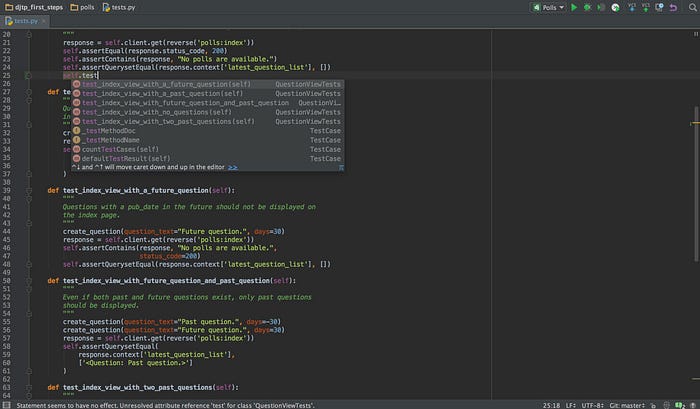
Image Source — PyCharm.
- Spyder

Image Source — Spyder.
- Category: IDE
- First Release Year: 2009
- Platform Compatibility: Windows, macOS, Linux
- Who It’s For: Python data scientists
- Price: Free
- Download: Spyder Download Link
Spyder comes with support for packages like NumPy, SciPy, Matplotlib, and Pandas. Targeted towards scientists, engineers, and data analysts, Spyder offers advanced data exploration, analysis, and visualization tools. Features of this cross-platform IDE include:
- Code completion
- Syntax highlighting
- Code benchmarking via Profiler
- Multi-project handling
- Find in Files feature
- History log
- Internal console for introspection
- Third-party plugins support
Advantages —
- Includes support for numerous scientific tools
- Comes with an amazing community support
- Interactive console
- Lightweight
Disadvantages —
- Comes with execution dependencies
- Can be a bit challenging at first for newcomers
Screenshot for Reference
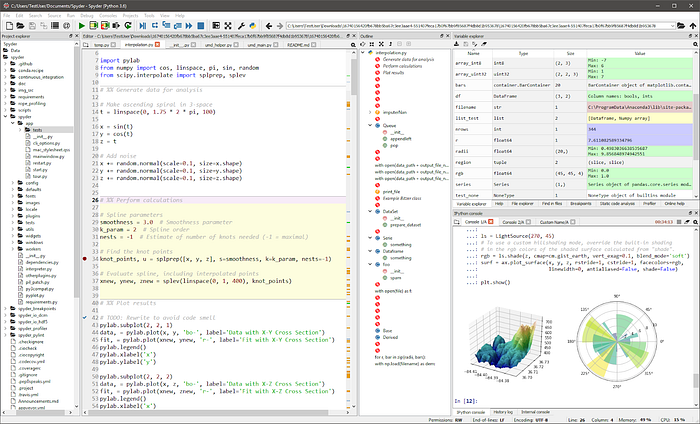
Image Source — Spyder.|
spyder-ide/spyder
- Eclipse + Pydev

- Category: IDE
- First Release Year: 2001 — for Eclipse, 2003 — for Pydev
- Platform Compatibility: Windows, macOS, Linux
- Who It’s For: Intermediate to advanced Python users
- Supporting Languages: Python, (Eclipse supports Java and many other programming languages)
- Price: Free
- Download: PyDev Download Link
- Popular Companies using PyDev and Eclipse Python IDE — Hike, Edify, Accenture, Wongnai, and Webedia.
Eclipse is one of the top IDEs available, supporting a broad range of programming languages for application development, including Python. Primarily created for developing Java applications, support for other programming languages is introduced via plugins. The plugin used for Python development is Pydev and offers additional benefits over Eclipse IDE, such as:
- Django, Pylint, and unit test integration
- Interactive console
- Remote debugger
- Go to definition
- Type hinting
- Auto code completion with auto import
Advantages —
- Easy to use
- Programmer friendly features
- Free
Disadvantages —
- Complex user interface makes it challenging to work with
- If you’re a beginner, then using Eclipse will be difficult
Screenshot for Reference
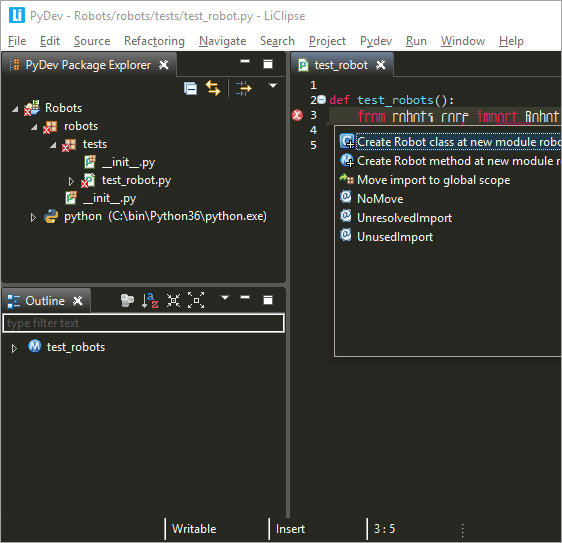
Image Source — Pydev.
- IDLE
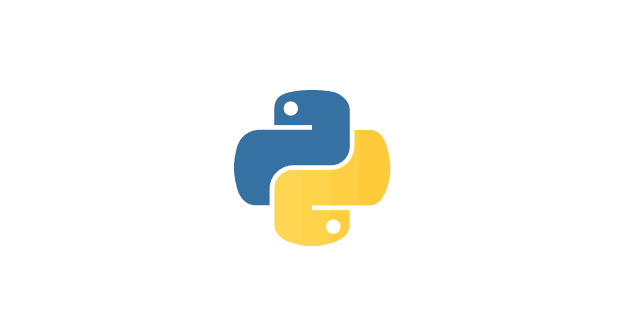
Image Source — Python.
- Category: IDE
- First Release Year: 1998
- Platform Compatibility: Windows, macOS, Linux
- Who It’s For: Beginning Python users
- Price: Free
- Download: IDLE Download Link
- Popular Companies using IDLE Python IDE — Google, Wikipedia, CERN, Yahoo, and NASA.
Short for Integrated Development and Learning Environment, IDLE has been bundled with Python as its default IDE for more than 15 years. IDLE is a cross-platform IDE and offers a basic set of features to keep it unburdened. The features offered include:
- Shell window with colorized code, input, output, and error messages
- Support for a multi-window text editor
- Code auto-completion
- Code formatting
- Search within files
- Debugger with breakpoints
- Supports smart indentation
Advantages —
- Perfect for beginners and educational institutions
Disadvantages —
- Lacks features offered by more advanced IDEs, such as project management capabilities
IDLE - Python 3.8.3 documentation
- Wing

Image Source — Wing.
- Category: IDE
- First Release Year: September 7, 2000
- Platform: Windows, Linux, and Mac
- Who It’s For: Intermediate to advanced Python users
- Price: $179 per user for a year of commercial use, $245 per user for a permanent commercial use license
- Download: Wing Download Link
- Popular Companies using Wing Python IDE — Facebook, Google, Intel, Apple, and NASA
The feature-rich IDE for Python, Wing, was developed to make development faster with the introduction of intelligent features such as smart editor and simple code navigation. Wing comes in 101, Personal, and Pro variants with Pro being the most feature-rich and the only paid one. Other notable features by Wing include:
- Code completion, error detection, and quality analysis
- Smart refactoring capabilities
- Interactive debugger
- Unit tester integration
- Customizable interface
- Support for remote development
- Support for frameworks such as Django, Flask, and more
Advantages —
- Works well with version control systems such as Git
- Strong debugging capabilities
Disadvantages —
- Lacks a compelling user interface
- Cloud9 IDE
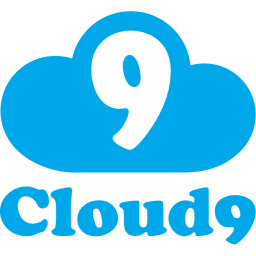
Image Source — AmazonCloud9.
- Category: IDE
- First Release Year: 2010
- Platform: Linux/MacOS/Windows
- Popular Companies using Cloud9 Python IDE — Linkedin, Salesforce, Mailchimp, Mozilla, Edify, and Soundcloud.
Part of Amazon’s Web Services, Cloud9 IDE gives you access to a cloud-based IDE, requiring just a browser. All the code is executed on Amazon’s infrastructure, translating to a seamless and lightweight development experience. Features include:
- Requires minimal project configuration
- Powerful code editor
- Code highlight, formatting, and completion capabilities
- Built-in terminal
- Strong debugger
- Real-time pair programming capabilities
- Instantaneous project setup, covering most programming languages and libraries
- Unobstructed access to several AWS services via terminal
Advantages —
- Enables painless development of serverless applications
- Remarkably robust and globally accessible infrastructure
Disadvantages —
- Depends entirely on internet access
- Sublime Text 3
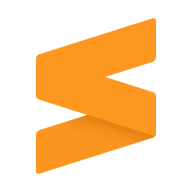
Image Source — Sublime.
- Category: Code Editor
- First Release Year: 2008
- Platform Compatibility: Windows, macOS, Linux
- Who It’s For: Beginner, Professional
- Supporting Languages: Python and C#
- Price: Freemium
- Download: Sublime text 3 Download Link
- Popular Companies using Sublime Text Python IDE — Starbucks, Myntra, Trivago, Stack, and Zapier.
Sublime Text is one of the most commonly used cross-platform Code Editors and supports several programming languages, including Python. Sublime offers various features such as plenty of themes for visual customization, a clean and distraction-free user interface, and supports package manager for extending the core functionality via plugins. Other features include:
- Up-to-date plugins via Package Manager
- File auto-save
- Macros
- Syntax highlight and code auto-completion
- Simultaneous code editing
- Go to anything, definition, and symbol
Advantages —
- Uncluttered user interface
- Split editing
- Fast and high-performance editor
Disadvantages —
- Annoying popup to buy sublime license
- Confusingly large number of shortcuts
- Complicated package manager
- Visual Studio Code

Image Source — Visual Studio Code.
- Category: IDE
- First Release Year: 2015
- Platform Compatibility: Windows, macOS, Linux
- Who It’s For: Professional
- Supporting Languages: All the major programming languages (Python, C++, C#, CSS, Dockerfile, Go, HTML, Java, JavaScript, JSON, Less, Markdown, PHP, PowerShell, Python, SCSS, T-SQL, TypeScript.)
- Price: Free
- Download: Visual Studio Code Download Link
- Popular Companies using Visual Source Code (Python IDE) — The Delta Group, TwentyEight, Inc., Focus Ponte Global, Creative Mettle, and National Audubon Society, Inc.
Developed by Microsoft, Visual Studio Code is an acclaimed cross-platform code editor that is highly customizable and allows development in several programming languages, including Python. It offers a wide variety of features to programmers, such as smart debugging, customizability, plugin support for extending core features. Key highlights include:
- Built-in support for Git and version control
- Code refactoring
- Integrated terminal
- IntelliSense for smarter code highlight and completion
- Intuitive code debugging capabilities
- Seamless deployment to Azure
Advantages —
- Regularly updated with active community support
- Free
Disadvantages —
- Vast collection of plugins can make finding the right one challenging
- Lackluster handling of large files
- Longer launch time
Screenshot for Reference
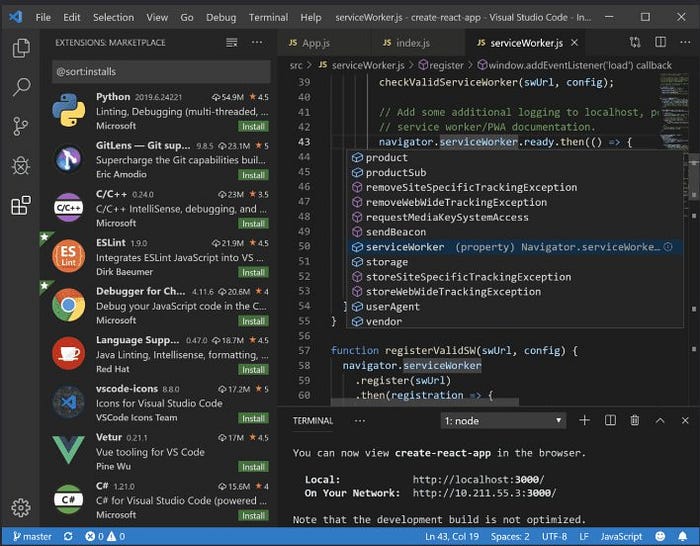
Image Source — Visual Studio Code.
- Atom

Image Source — Atom.
- Category: Code Editor
- First Release Year: 2014
- Platform Compatibility: Windows, macOS, Linux
- Who It’s For: Beginner, Professional
- Supporting Languages: Python, HTML, Java and 34 other languages.
- Price: Free
- Download: Atom Download Link
- Popular Companies using Atom (Python IDE) — Accenture, Hubspot, Figma, Lyft, and Typeform.
Developed by Github, the top dog in source-code hosting and software version controlling, Atom is a lightweight and cross-platform Code Editor for Python and many other programming languages. Atom provides a lot of features in the form of packages, that enhances its core features. It’s built on HTML, JavaScript, CSS, and Node.js, with the underlying framework being Electron. Features offered include:
- Support for third-party packages via built-in Package Manager
- Supports developer collaboration
- Over 8000 feature and user experience-extending packages
- Support for multi-pane file access
- Smart code completion
- Customizability options
Advantages —
- Lightweight code editor
- Community-driven development and support
Disadvantages —
- Recent updates have increased RAM usage
- Some tweaking required in settings before use
- Jupyter

Image source — Jupyter.
- Category: IDE
- First Release Year: February 2015
- Browser Compatibility: Chrome, Firefox, Safari
- Price: Free
- Download: Jupyter Download Link
- Popular Companies of Using Jupyter Python IDE — Google, Bloomberg, Microsoft, IBM, and Soundcloud.
Also known as Project Jupyter, it is an open-source and cross-platform IDE that many data scientists and analysts prefer over other tools. Perfect for working on technologies such as AI, ML, DL, along with several programming languages, Python included. Jupyter Notebooks offer seamless creation and sharing of code, text, and equations for various purposes, including analysis, visualization, and development. Features offered include:
- Code formatting and highlight
- Easy sharing via email, Dropbox
- Produces interactive output
- Plays well with Big Data
- Can be run from local and cloud machines
Advantages —
- Requires minimal setup
- Perfect for quick data analysis
Disadvantages —
- Inexperienced users may find Jupyter complicated
Screenshot for Reference

Image source — Jupyter.
How to Choose Best Python IDEs and Code Editors for Yourself
Picking the right IDE or Code Editor can mean the difference in saving time with quicker development or losing it due to reckless decisions. We have mentioned a lot of IDEs and Code Editors in the previous section with some of its noteworthy features. If you’re confused about which one you should pick for your next Python project, then we recommend you give it a quick read. After all, what would a programmer be without a proper set of IDEs and Code Editors?
Note: To eliminate problems of different kinds, I want to alert you to the fact this article represents just my personal opinion I want to share, and you possess every right to disagree with it.
Original. Reposted with permission.
Bio: Claire D. Costa is a Content Crafter and Marketer at Digitalogy, a tech sourcing and custom matchmaking marketplace that connects people with pre-screened and top-notch developers and designers based on their specific needs across the globe.
Related:

 Best Python IDEs and Code Editors You Should Know
Best Python IDEs and Code Editors You Should Know